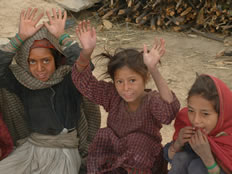| Explore Nepal - Page 2 |
 |
 |
 |
|
Page 2 of 7
People: The population is divided into two broad ethnic groups. (1.) The Indo-Nepalese which include the Pahari, Newar, Tharu and the Indians of the Tarai, all of which account for nearly 80% of the population. (2.) Tibeto-Nepalese who account for the remainder and include the more numerous Tamang, Rai, Limbu, Bhote, Sunwar, Magar and Gurung tribes. The Tibeto-Nepalese are related racially and culturally to the Tibetans.  In Nepal, ethnic cultural groups are diverse and many of them have their own languages and customs. However, they can be geographically categorized according to their habitats. The Sherpas who are of Tibeto-Burman stock mainly occupy the higher hills of eastern and central Nepal. The Solu Khumbu region, where the world's tallest peak Mt. Everest stands, is inhabited by Sherpas. Generally they are Buddhist but some follow the Bon, the pre-Buddhist religion of Tibet, and other religions. The Sherpas are famed for their valor and mountaineering skills and are professionally involved in many mountain expeditions. Today, Sherpas have joined other occupations as well, like business, administration and politics. In Nepal, ethnic cultural groups are diverse and many of them have their own languages and customs. However, they can be geographically categorized according to their habitats. The Sherpas who are of Tibeto-Burman stock mainly occupy the higher hills of eastern and central Nepal. The Solu Khumbu region, where the world's tallest peak Mt. Everest stands, is inhabited by Sherpas. Generally they are Buddhist but some follow the Bon, the pre-Buddhist religion of Tibet, and other religions. The Sherpas are famed for their valor and mountaineering skills and are professionally involved in many mountain expeditions. Today, Sherpas have joined other occupations as well, like business, administration and politics.
A wide variety of ethnic groups occupy the mid-hills. The Kirats or Limbus and Rais inhabit bur are ancestor worshipers. However, today, many embrace Hinduism. In the former days, they were warriors and skilled hunters. The Kirats speak Tibeto-Burman languages. Many serve in the British army today and have earned a reputation as the brave Gurkhas.

|